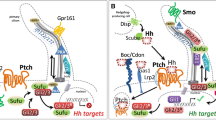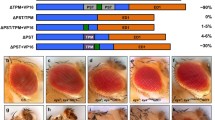Abstract
The paired-type homeodomain transcription factor Otx2 is essential for forebrain and eye development. Severe ocular malformations in humans have recently been associated with heterozygous OTX2 mutations. To document the molecular defects in human mutants, Otx2 structural characterization was carried out. A collection of deletion and point mutants was created to perform transactivation, DNA binding, and subcellular localization analyses. Transactivation was ascribed to both N- and C-termini of the protein, and DNA binding to the minimal homeodomain, where critical amino acid residues were identified. Acute nuclear localization appeared controlled by a nuclear localization sequence located within the homeodomain which acts in conjunction with a novel nuclear retention domain that we unraveled located in the central part of the protein. This region, which is poorly conserved among Otx proteins, was also endowed with dominant negative activity suggesting that it might confer unique properties to Otx2. Molecular diagnostic of human mutant OTX2 proteins discriminates hypomorphic and loss of function mutations from other mutations that may not be relevant to ocular pathology.





Similar content being viewed by others
Abbreviations
- NLS:
-
Nuclear localization sequence
- aa:
-
Amino acid
- bts:
-
Bicoid target site
References
Muller P, Yanze N, Schmid V, Spring J (1999) The homeobox gene Otx of the jellyfish Podocoryne carnea: role of a head gene in striated muscle and evolution. Dev Biol 216:582–594
Galliot B, de Vargas C, Miller D (1999) Evolution of homeobox genes: Q50 Paired-like genes founded the Paired class. Dev Genes Evol 209:186–197
Germot A, Lecointre G, Plouhinec JL, Le Mentec C, Girardot F, Mazan S (2001) Structural evolution of Otx genes in craniates. Mol Biol Evol 18:1668–1678
Rhinn M, Dierich A, Le Meur M, Ang S (1999) Cell autonomous and non-cell autonomous functions of Otx2 in patterning the rostral brain. Development 126:4295–4304
Kimura C, Yoshinaga K, Tian E, Suzuki M, Aizawa S, Matsuo I (2000) Visceral endoderm mediates forebrain development by suppressing posteriorizing signals. Dev Biol 225:304–321
Zuber ME, Gestri G, Viczian AS, Barsacchi G, Harris WA (2003) Specification of the vertebrate eye by a network of eye field transcription factors. Development 130:5155–5167
Martinez-Morales JR, Signore M, Acampora D, Simeone A, Bovolenta P (2001) Otx genes are required for tissue specification in the developing eye. Development 128:2019–2030
Nishida A, Furukawa A, Koike C et al (2003) Otx2 homeobox gene controls retinal photoreceptor cell fate and pineal gland development. Nat Neurosci 6:1255–1263
Fossat N, Courtois V, Chatelain G, Brun G, Lamonerie T (2005) Alternative usage of Otx2 promoters during mouse development. Dev Dyn 233:154–160
Courtois V, Chatelain G, Han ZY, Le Novere N, Brun G, Lamonerie T (2003) New Otx2 mRNA isoforms expressed in the mouse brain. J Neurochem 84:840–853
Kurokawa D, Takasaki N, Kiyonari H et al (2004) Regulation of Otx2 expression and its functions in mouse epiblast and anterior neuroectoderm. Development 131:3307–3317
Kurokawa D, Kiyonari H, Nakayama R, Kimura-Yoshida C, Matsuo I, Aizawa S (2004) Regulation of Otx2 expression and its functions in mouse forebrain and midbrain. Development 131:3319–3331
Matsuo I, Kuratani S, Kimura C, Takeda N, Aizawa S (1995) Mouse Otx2 functions in the formation and patterning of rostral head. Genes Dev 9:2646–2658
Ragge NK, Brown AG, Poloschek CM et al (2005) Heterozygous mutations of OTX2 cause severe ocular malformations. Am J Hum Genet 76
Zernicka-Goetz M, Pines J, Ryan K et al (1996) An indelible lineage marker for Xenopus using a mutated green fluorescent protein. Development 122:3719–3724
Hiriart E, Farjot G, Gruffat H, Nguyen MV, Sergeant A, Manet E (2003) A novel nuclear export signal and a REF interaction domain both promote mRNA export by the Epstein–Barr virus EB2 protein. J Biol Chem 278:335–342
Fong SL, Fong WB (1999) Elements regulating the transcription of human interstitial retinoid-binding protein (IRBP) gene in cultured retinoblastoma cells. Curr Eye Res 18:283–291
Chelsky D, Ralph R, Jonak G (1989) Sequence requirements for synthetic peptide-mediated translocation to the nucleus. Mol Cell Biol 9:2487–2492
Pollock R, Treisman R (1990) A sensitive method for the determination of protein–DNA binding specificities. Nucleic Acids Res 18:6197–6204
Freund CL, Gregory-Evans CY, Furukawa T et al (1997) Cone–rod dystrophy due to mutations in a novel photoreceptor-specific homeobox gene (CRX) essential for maintenance of the photoreceptor. Cell 91:543–553
Chen S, Wang QL, Nie Z et al (1997) Crx, a novel Otx-like paired-homeodomain protein, binds to and transactivates photoreceptor cell-specific genes. Neuron 19:1017–1030
Fraenkel E, Pabo CO (1998) Comparison of X-ray and NMR structures for the Antennapedia homeodomain–DNA complex. Nat Struct Biol 5:692–697
Hanes SD, Riddihough G, Ish-Horowicz D, Brent R (1994) Specific DNA recognition and intersite spacing are critical for action of the bicoid morphogen. Mol Cell Biol 14:3364–3375
Briata P, Ilengo C, Bobola N, Corte G (1999) Binding properties of the human homeodomain protein OTX2 to a DNA target sequence. FEBS Lett 445:160–164
Simeone A, Acampora D, Mallamaci A et al (1993) A vertebrate gene related to orthodenticle contains a homeodomain of the bicoid class and demarcates anterior neuroectoderm in the gastrulating mouse embryo. EMBO J 12:2735–2747
Pratt G, Hough R, Rechsteiner M (1989) Proteolysis in heat-stressed HeLa cells. Stabilization of ubiquitin correlates with the loss of proline endopeptidase. J Biol Chem 264:12526–12532
Mallamaci A, Di Blas E, Briata P, Boncinelli E, Corte G (1996) OTX2 homeoprotein in the developing central nervous system and migratory cells of the olfactory area. Mech Dev 58:165–178
Nothias F, Fishell G, Ruiz i Altaba A (1998) Cooperation of intrinsic and extrinsic signals in the elaboration of regional identity in the posterior cerebral cortex. Curr Biol 8:459–462
Hodel MR, Corbett AH, Hodel AE (2001) Dissection of a nuclear localization signal. J Biol Chem 276:1317–1325
Chau KY, Chen S, Zack DJ, Ono SJ (2000) Functional domains of the cone–rod homeobox (CRX) transcription factor. J Biol Chem 275:37264–37270
Chaney BA, Clark-Baldwin K, Dave V, Ma J, Rance M (2005) Solution structure of the K50 class homeodomain PITX2 bound to DNA and implications for mutations that cause Rieger syndrome. Biochemistry 44:7497–7511
Martinez-Morales JR, Dolez V, Rodrigo I et al (2003) OTX2 activates the molecular network underlying retina pigment epithelium differentiation. J Biol Chem 278:21721–21731
Montalta-He H, Leemans R, Loop T et al (2002) Evolutionary conservation of otd/Otx2 transcription factor action: a genome-wide microarray analysis in Drosophila. Genome Biol 3:RESEARCH0015
Takeda K, Yokoyama S, Yasumoto K et al (2003) OTX2 regulates expression of DOPAchrome tautomerase in human retinal pigment epithelium. Biochem Biophys Res Commun 300:908–914
Wilson D, Sheng G, Lecuit T, Dostatni N, Desplan C (1993) Cooperative dimerization of paired class homeo domains on DNA. Genes Dev 7:2120–2134
Wilson DS, Sheng G, Jun S, Desplan C (1996) Conservation and diversification in homeodomain–DNA interactions: a comparative genetic analysis. Proc Natl Acad Sci U S A 93:6886–6891
Nakano T, Murata T, Matsuo I, Aizawa S (2000) OTX2 directly interacts with LIM1 and HNF-3beta. Biochem Biophys Res Commun 267:64–70
Fei Y, Hughes TE (2000) Nuclear trafficking of photoreceptor protein crx: the targeting sequence and pathologic implications. Invest Ophthalmol Vis Sci 41:2849–2856
Zhang YA, Okada A, Lew CH, McConnell SK (2002) Regulated nuclear trafficking of the homeodomain protein otx1 in cortical neurons. Mol Cell Neurosci 19:430–446
Howe KJ (2002) RNA polymerase II conducts a symphony of pre-mRNA processing activities. Biochim Biophys Acta 1577:308–324
Nicoll JB, Gwinn BL, Iwig JS, Garcia PP, Bunn CF, Allison LA (2003) Compartment-specific phosphorylation of rat thyroid hormone receptor alpha1 regulates nuclear localization and retention. Mol Cell Endocrinol 205:65–77
Friedman JS, Khanna H, Swain PK et al (2004) The minimal transactivation domain of the basic motif-leucine zipper transcription factor NRL interacts with TATA-binding protein. J Biol Chem 279:47233–47241
Acknowledgements
We thank Jérôme Lacroix who contributed to this work as an undergraduate student, Evelyne Manet and Alain Sergeant for helpful discussions, and Charlie Scutt for improving the manuscript. NF is a recipient of a fellowship of the French Ministry of Research and Education. This work was supported by grants from the CNRS, the Retina France association, and the Comité du Rhône of the Ligue Nationale contre le Cancer.
Author information
Authors and Affiliations
Corresponding author
Rights and permissions
About this article
Cite this article
Chatelain, G., Fossat, N., Brun, G. et al. Molecular dissection reveals decreased activity and not dominant negative effect in human OTX2 mutants. J Mol Med 84, 604–615 (2006). https://doi.org/10.1007/s00109-006-0048-2
Received:
Accepted:
Published:
Issue Date:
DOI: https://doi.org/10.1007/s00109-006-0048-2




